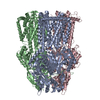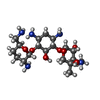+ Open data
Open data
- Basic information
Basic information
| Entry | Database: PDB / ID: 8f4r | |||||||||||||||||||||||||||||||||||||||||||||||||||||||||||||||||||||||||||||||||||||||||||||||||||
|---|---|---|---|---|---|---|---|---|---|---|---|---|---|---|---|---|---|---|---|---|---|---|---|---|---|---|---|---|---|---|---|---|---|---|---|---|---|---|---|---|---|---|---|---|---|---|---|---|---|---|---|---|---|---|---|---|---|---|---|---|---|---|---|---|---|---|---|---|---|---|---|---|---|---|---|---|---|---|---|---|---|---|---|---|---|---|---|---|---|---|---|---|---|---|---|---|---|---|---|---|
| Title | Gentamicin bound aminoglycoside efflux pump AcrD | |||||||||||||||||||||||||||||||||||||||||||||||||||||||||||||||||||||||||||||||||||||||||||||||||||
 Components Components | Efflux pump membrane transporter | |||||||||||||||||||||||||||||||||||||||||||||||||||||||||||||||||||||||||||||||||||||||||||||||||||
 Keywords Keywords | MEMBRANE PROTEIN / aminoglycoside efflux pump / AcrD / E.coli | |||||||||||||||||||||||||||||||||||||||||||||||||||||||||||||||||||||||||||||||||||||||||||||||||||
| Function / homology |  Function and homology information Function and homology informationefflux transmembrane transporter activity / xenobiotic transmembrane transporter activity / plasma membrane Similarity search - Function | |||||||||||||||||||||||||||||||||||||||||||||||||||||||||||||||||||||||||||||||||||||||||||||||||||
| Biological species |  | |||||||||||||||||||||||||||||||||||||||||||||||||||||||||||||||||||||||||||||||||||||||||||||||||||
| Method | ELECTRON MICROSCOPY / single particle reconstruction / cryo EM / Resolution: 3.06 Å | |||||||||||||||||||||||||||||||||||||||||||||||||||||||||||||||||||||||||||||||||||||||||||||||||||
 Authors Authors | Zhang, Z. | |||||||||||||||||||||||||||||||||||||||||||||||||||||||||||||||||||||||||||||||||||||||||||||||||||
| Funding support |  United States, 1items United States, 1items
| |||||||||||||||||||||||||||||||||||||||||||||||||||||||||||||||||||||||||||||||||||||||||||||||||||
 Citation Citation |  Journal: mBio / Year: 2023 Journal: mBio / Year: 2023Title: Cryo-EM Structures of AcrD Illuminate a Mechanism for Capturing Aminoglycosides from Its Central Cavity. Authors: Zhemin Zhang / Christopher E Morgan / Meng Cui / Edward W Yu /  Abstract: The Escherichia coli acriflavine resistance protein D (AcrD) is an efflux pump that belongs to the resistance-nodulation-cell division (RND) superfamily. Its primary function is to provide resistance ...The Escherichia coli acriflavine resistance protein D (AcrD) is an efflux pump that belongs to the resistance-nodulation-cell division (RND) superfamily. Its primary function is to provide resistance to aminoglycoside-based drugs by actively extruding these noxious compounds out of E. coli cells. AcrD can also mediate resistance to a limited range of other amphiphilic agents, including bile acids, novobiocin, and fusidic acids. As there is no structural information available for any aminoglycoside-specific RND pump, here we describe cryo-electron microscopy (cryo-EM) structures of AcrD in the absence and presence of bound gentamicin. These structures provide new information about the RND superfamily of efflux pumps, specifically, that three negatively charged residues central to the aminoglycoside-binding site are located within the ceiling of the central cavity of the AcrD trimer. Thus, it is likely that AcrD is capable of picking up aminoglycosides via this central cavity. Through the combination of cryo-EM structural determination, mutagenesis analysis, and molecular simulation, we show that charged residues are critically important for this pump to shuttle drugs directly from the central cavity to the funnel of the AcrD trimer for extrusion. Here, we report cryo-EM structures of the AcrD aminoglycoside efflux pump in the absence and presence of bound gentamicin, posing the possibility that this pump is capable of capturing aminoglycosides from the central cavity of the AcrD trimer. The results indicate that AcrD utilizes charged residues to bind and export drugs, mediating resistance to these antibiotics. | |||||||||||||||||||||||||||||||||||||||||||||||||||||||||||||||||||||||||||||||||||||||||||||||||||
| History |
|
- Structure visualization
Structure visualization
| Structure viewer | Molecule:  Molmil Molmil Jmol/JSmol Jmol/JSmol |
|---|
- Downloads & links
Downloads & links
- Download
Download
| PDBx/mmCIF format |  8f4r.cif.gz 8f4r.cif.gz | 509.5 KB | Display |  PDBx/mmCIF format PDBx/mmCIF format |
|---|---|---|---|---|
| PDB format |  pdb8f4r.ent.gz pdb8f4r.ent.gz | 412.9 KB | Display |  PDB format PDB format |
| PDBx/mmJSON format |  8f4r.json.gz 8f4r.json.gz | Tree view |  PDBx/mmJSON format PDBx/mmJSON format | |
| Others |  Other downloads Other downloads |
-Validation report
| Summary document |  8f4r_validation.pdf.gz 8f4r_validation.pdf.gz | 1.7 MB | Display |  wwPDB validaton report wwPDB validaton report |
|---|---|---|---|---|
| Full document |  8f4r_full_validation.pdf.gz 8f4r_full_validation.pdf.gz | 1.8 MB | Display | |
| Data in XML |  8f4r_validation.xml.gz 8f4r_validation.xml.gz | 90.5 KB | Display | |
| Data in CIF |  8f4r_validation.cif.gz 8f4r_validation.cif.gz | 140 KB | Display | |
| Arichive directory |  https://data.pdbj.org/pub/pdb/validation_reports/f4/8f4r https://data.pdbj.org/pub/pdb/validation_reports/f4/8f4r ftp://data.pdbj.org/pub/pdb/validation_reports/f4/8f4r ftp://data.pdbj.org/pub/pdb/validation_reports/f4/8f4r | HTTPS FTP |
-Related structure data
| Related structure data |  28857MC  8f3eC  8f4nC  8f56C M: map data used to model this data C: citing same article ( |
|---|---|
| Similar structure data | Similarity search - Function & homology  F&H Search F&H Search |
- Links
Links
- Assembly
Assembly
| Deposited unit | 
|
|---|---|
| 1 |
|
- Components
Components
| #1: Protein | Mass: 113139.891 Da / Num. of mol.: 3 Source method: isolated from a genetically manipulated source Source: (gene. exp.)  Gene: acrD, ACU57_04565, BANRA_03325, BJI68_01485, BJJ90_06945, BMT91_11990, BON93_11695, BUO55_002264, C0P57_000121, C5N07_10560, C5Y87_22760, C9160_05345, CTR35_000190, CX938_001812, D3Y67_13030, ...Gene: acrD, ACU57_04565, BANRA_03325, BJI68_01485, BJJ90_06945, BMT91_11990, BON93_11695, BUO55_002264, C0P57_000121, C5N07_10560, C5Y87_22760, C9160_05345, CTR35_000190, CX938_001812, D3Y67_13030, DAH22_02795, DAH27_02260, DAH28_02170, DAH32_09030, DAH37_20010, DAH41_00685, DAH50_04680, DIV22_31685, E2119_05090, E2122_05015, E2127_22975, E2128_11985, E2132_10115, E2134_09425, E4T14_01660, E5P26_05645, E5P27_06290, E5P28_04085, E5P29_08410, E5P31_03360, E5P32_02065, E5P40_06505, E5P51_11900, E5S36_11905, E5S45_03290, EC1094V2_1219, ECs3332, ED648_19550, EI021_07760, EIZ93_19695, EKI52_22415, EL79_1194, EL80_1199, ELT21_03480, ERS139208_00580, EYV17_00615, EYV18_00295, F2N20_03885, F2N31_04825, F9V24_02735, FFF58_09795, FOI11_000625, FOI11_19425, FQF29_08200, G3V95_05155, G4A38_06285, G4A47_09235, GJO56_19765, GKF89_16975, GOP25_13330, GP975_00825, GRW05_00965, HMV95_10675, HNC36_05080, HX136_06730, IH772_01085, J0541_000250, JNP96_20105, NCTC8960_04125, NCTC9037_01546, SAMEA3472044_02066, SAMEA3753106_01071 Production host:  #2: Chemical | ChemComp-LLL / ( | Has ligand of interest | Y | Has protein modification | N | |
|---|
-Experimental details
-Experiment
| Experiment | Method: ELECTRON MICROSCOPY |
|---|---|
| EM experiment | Aggregation state: PARTICLE / 3D reconstruction method: single particle reconstruction |
- Sample preparation
Sample preparation
| Component | Name: AcrD / Type: COMPLEX / Entity ID: #1 / Source: RECOMBINANT |
|---|---|
| Source (natural) | Organism:  |
| Source (recombinant) | Organism:  |
| Buffer solution | pH: 7.5 |
| Specimen | Embedding applied: NO / Shadowing applied: NO / Staining applied: NO / Vitrification applied: YES |
| Vitrification | Cryogen name: ETHANE |
- Electron microscopy imaging
Electron microscopy imaging
| Experimental equipment |  Model: Titan Krios / Image courtesy: FEI Company |
|---|---|
| Microscopy | Model: FEI TITAN KRIOS |
| Electron gun | Electron source:  FIELD EMISSION GUN / Accelerating voltage: 300 kV / Illumination mode: FLOOD BEAM FIELD EMISSION GUN / Accelerating voltage: 300 kV / Illumination mode: FLOOD BEAM |
| Electron lens | Mode: BRIGHT FIELD / Nominal magnification: 81000 X / Nominal defocus max: 1500 nm / Nominal defocus min: 800 nm |
| Image recording | Electron dose: 35.9 e/Å2 / Film or detector model: GATAN K3 BIOQUANTUM (6k x 4k) |
- Processing
Processing
| Software | Name: PHENIX / Version: 1.20.1_4487: / Classification: refinement | ||||||||||||||||||||||||
|---|---|---|---|---|---|---|---|---|---|---|---|---|---|---|---|---|---|---|---|---|---|---|---|---|---|
| EM software | Name: PHENIX / Category: model refinement | ||||||||||||||||||||||||
| CTF correction | Type: PHASE FLIPPING AND AMPLITUDE CORRECTION | ||||||||||||||||||||||||
| 3D reconstruction | Resolution: 3.06 Å / Resolution method: FSC 0.143 CUT-OFF / Num. of particles: 36919 / Symmetry type: POINT | ||||||||||||||||||||||||
| Refine LS restraints |
|
 Movie
Movie Controller
Controller






 PDBj
PDBj


